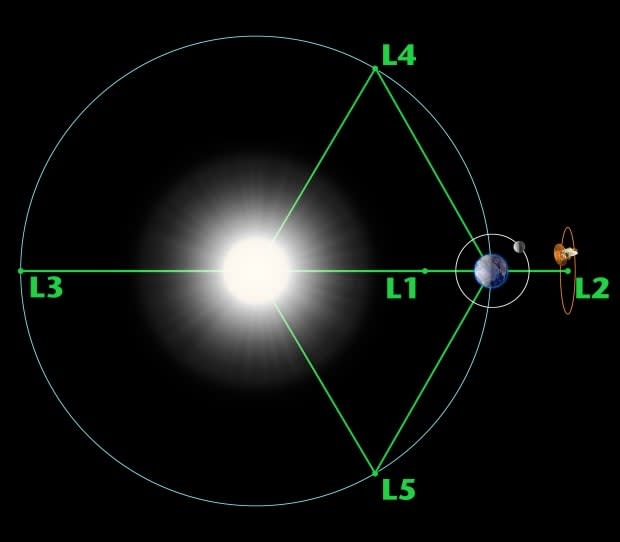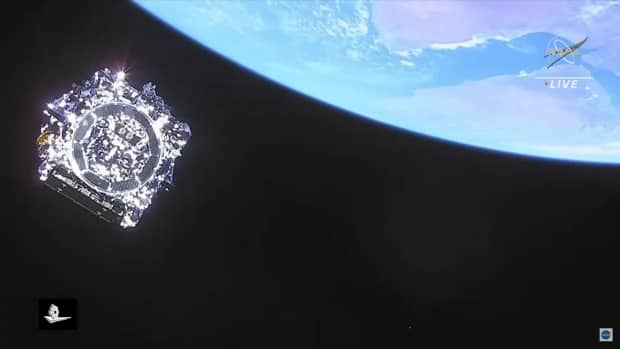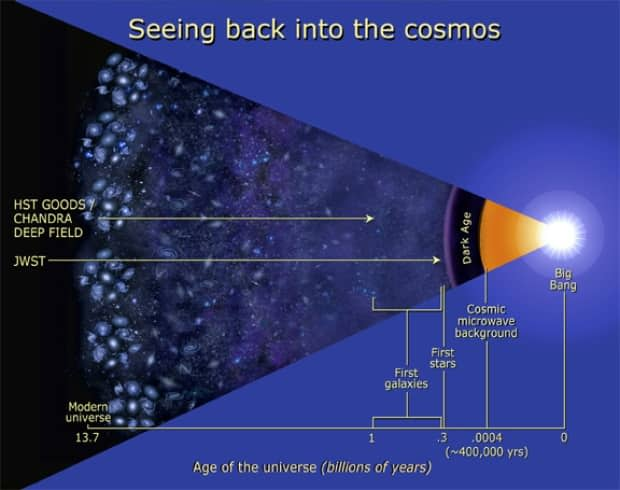Webb telescope arrives safely. Now, Canadian astronomers are ready to unravel the mysteries of the universe

There's been a lot of breath-holding since the James Webb Space Telescope (JWST) launched on Dec. 25, but now astronomers can exhale: The $10-billion US telescope safely reached its destination Monday afternoon.
"We're just really excited to announce today that Webb is officially on station at its L2 orbit," Keith Parrish, Webb observatory commissioning manager at NASA's Goddard Space Flight Center said in a media teleconference. "This is just capping off a remarkable 30 days."
Lagrange Points are a kind of sweet spot in space where there is a pull between two objects like the sun and Earth and spacecraft can operate in either a stable or semi-stable orbit. Webb will sit at Lagrangian Point 2, or L2.
Webb is the successor to the Hubble Space Telescope, launched in 1990. Hubble is still hard at work, providing astronomers with insight into our universe, but Webb is a new and improved telescope that will peer further back to a time when our universe was in its infancy.
Although Webb has arrived safely at the Lagrange Point 2, the telescope will still undergo several months of testing to ensure everything is functioning properly.
After that, the science begins.

"It's going to be amazing when we get the first data coming back," said Chris Willott, an astronomer with National Research Council Canada's Herzberg Astronomy and Astrophysics Research Centre.
"I can't even predict the things we're going to discover just within the first year. There are so many new things we're going to discover."
WATCH | The National: Canadian researchers await images from the James Webb telescope
Willott heads the CAnadian NIRISS Unbiased Cluster Survey (CANUCS) observing program, which will study some of the first galaxies that formed, as well as galaxy clusters. NIRISS stands for Near-Infrared Imager and Slitless Spectrograph.
One of the things Willott is most interested in is black holes.
"We know that today most galaxies have large black holes in their centres, including our own galaxy," he said. "So I'll be trying to look at how those black holes got started in the very early universe because we know that some of them got very large, very quickly, which is kind of surprising."

Large telescopes (even ground-based ones) are available to professional astronomers who want to use them. However, they first have to submit proposals and have them approved.
The reason Willott and more than a dozen other Canadian astronomers are getting time on Webb is that Canada contributed to the groundbreaking telescope by providing instruments: the fine-guidance sensor, which allows it to point and focus on objects, and the NIRISS that will be used to study the composition of the atmospheres on distant planets — called exoplanets — that orbit other stars.
Now, these astronomers are eagerly awaiting their time to study everything from the earliest galaxy formations to rogue planets (planets that don't have stars), and look for possible signs of life on other exoplanets.
Using Webb, they will practically time-travel as they look back to a nascent universe.
Black holes and habitable worlds
Any light that reaches us takes time. The light from the sun takes eight minutes to reach us. So, when we (safely) look at the sun, we are looking at it as it was eight minutes ago.
The same applies to any light that reaches us from stars or galaxies. The farther they are, the farther back in time we're looking. But we need powerful telescopes to look farther back, and Webb is the most powerful telescope capable of doing that.
To put it in perspective, our universe is roughly 13.8 billion years old. Webb will be able to see back to when it was roughly 100 million years old, when the first stars and galaxies were forming.
WATCH | The National: Why Webb is such a big deal:
Els Peeters will be one of the first Canadian astronomers to use Webb. Her research centres around radiation — which is mostly seen in infrared light, something that Webb is built to see in — and how it influences young stars. Until now, she hasn't been able to peer through the dust and debris that so often surrounds nebulas hosting young stars.
"The way I think about it is if you take a picture of a crowd cheering on, for example, a basketball game of the Raptors — with the old cameras, every face of the person would be maybe four pixels," said Peeters, who is a professor in the physics and astronomy department at Western University in London, Ont.
"With the new cameras, every face, [will be] maybe 1,000 pixels. And so if you have many, many pixels over the same area, that means that you can track how the characteristics of a person's face can change.
"Now, you can say 'has blue eyes,' 'it has a broad nose' or 'a tiny nose' and these kinds of stuff."

This preciseness will allow her and her team to study new star formation in an unprecedented way.
Erik Rosolowsky is an associate professor of physics at Edmonton's University of Alberta who will be using the telescope to study star formation.
"What I'm going to be doing is trying to establish how long it takes for stars to form," he said. "This is a big question in astrophysics, and you might think that this is a boring kind of science topic or something, but the time it takes for stars to form actually tells us a bunch about how they form."
And that can tell us a lot about not only our universe, but our galaxy as well as perhaps our own solar system.
"With James Webb, for the first time, we [will be able to] see individual stars forming in this nearby spiral galaxy called the Triangulum Galaxy," Roslowsky said. "It's a relatively simple experiment, but it's been impossible to do until we've had the capabilities of the James Webb Space Telescope."
One of the most intriguing observations will be of the TRAPPIST-1 system.
TRAPPIST-1 is a star system with seven rocky planets in orbit in the star's habitable zone (where water can exist on a planet's surface).
"We don't know if those planets have an atmosphere or not," said Olivia Lim, a Ph.D. student at the University of Montreal who will be using Webb to study the atmospheres of the innermost of these planets — the ones with the best chance of habitability.
LISTEN | Quirks and Quarks: Webb launches with some help from Canada
"They might be balls of rock with no atmosphere at all, we don't know that. So we're trying to figure that out," she said. "If they do have an atmosphere, that means there may be a chance to look for traces of life in those atmospheres."
Studying these things — star and galaxy formation, the atmospheres of distant exoplanets — may seem inconsequential and unimportant. But astronomers believe that it's all part of humanity: understanding our place in the universe.
"It's really about understanding our whole universe, understanding where we came from and what the future will be," Willott said. "It's a fundamental question for humans, I think, to understand, you know, what are we doing here and what is the nature of the universe?"


